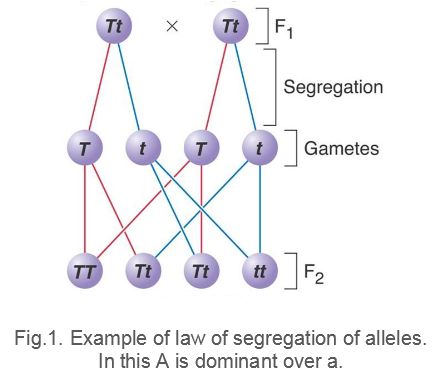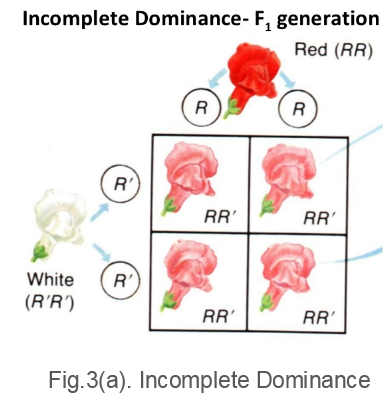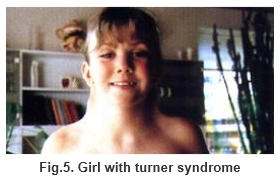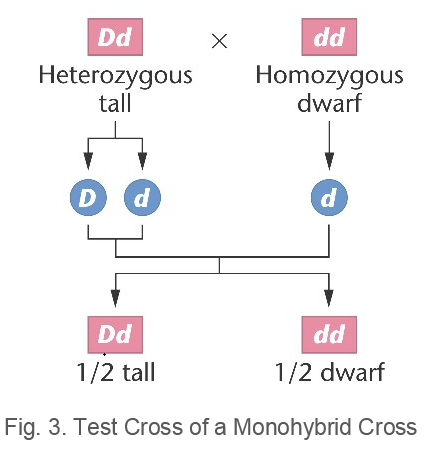Principles of Inheritance and Variation Revision Notes
Table of Content |

What is Heredity?
Heredity is a process of transmission of traits from parents to their offspring’s either via asexual reproduction or sexual reproduction. These characteristics or traits are located on the chromosomes in the form of genes.
Gregor Johann Mendel- “Father of Genetics”
Mendel was born in 1822 in Heinzendorf, which was a part of Czechoslovakia. His genetic experiments were conducted on garden pea, Pisum sativum in 1856 in the garden at the monastery.
Mendel used the pea plant for his experiments because of the following reasons:
-
Life span of pea plant is short
-
Flowers are self-pollinated.
-
Flowers were hermaphrodite as well as bisexual.
Mendel’s Laws
There were 3 laws that were proposed by Mendel after different experiments on Pea plant.
 1. Law of dominance- The effect of recessive allele is masked by the dominant allele. Only dominant allele expresses its phenotype.
1. Law of dominance- The effect of recessive allele is masked by the dominant allele. Only dominant allele expresses its phenotype.
For example: “Allele for tallness is dominant over allele for dwarfism”.
2. Law of segregation of genes- Each individual possesses two alleles of a gene and each allele separates or segregates at the time of meiosis, that is, during the formation of gametes. The monohybrid cross (cross of single trait) was used to explain the law of segregation of genes. (See Fig. 1).
3. Law of independent assortment – It states that alleles for separate traits are passed independently from parents to the offspring’s. Mendel used dihybrid (cross of two different traits) cross in order to explain independent assortment. (See Fig. 2)
Fig. 2. Law of independent assortment. Yellow round is dominant to green wrinkled.
Test Cross
A cross between first generation (F1) hybrids with its homozygous recessive parent is described as Test Cross. It determines whether dominant phenotype is homozygous or heterozygous in nature. (See Fig.3)
 Incomplete Dominance
Incomplete Dominance
When a dominant allele is not completely dominant over recessive allele and the F1 hybrid forms after crossing is intermediate between the two parents, the phenomenon is called incomplete dominance.
“For example: Flower color in Mirabilis jalapa, (4’O clock plant). When homozygous red (RR) flower is crossed with white (rr) flower, the F1 offsprings form will have pink flowers (Rr). The phenotypic ratio as well as genotypic ratio in F2 generation is 1:2:1”.See Fig. 3(a)
Multiple Allelism or Co-dominance
 When a gene exists in more than two allelic forms, the phenomenon is known as multiple allelism. “For example: multiple alleles is the inheritance of A, B and O blood groups in human being”. The gene for blood group occurs in three allelic forms IA, IB and i. An individual can possess any two of these alleles. The gene IA codes for glycoprotein A which is responsible for A blood group and gene IB codes for glycoprotein B which is responsible for blood group B.
When a gene exists in more than two allelic forms, the phenomenon is known as multiple allelism. “For example: multiple alleles is the inheritance of A, B and O blood groups in human being”. The gene for blood group occurs in three allelic forms IA, IB and i. An individual can possess any two of these alleles. The gene IA codes for glycoprotein A which is responsible for A blood group and gene IB codes for glycoprotein B which is responsible for blood group B.
The gene ‘i’ do not produce any glycoprotein and so the person who is homozygous for it, will have O group blood. The genes IA and IB are dominant over ‘i’. IA and IB alleles are equally dominant and produce both glycoproteins A and B and the blood group is AB. Such alleles are known as co-dominant alleles See Fig. 4
Chromosome theory of Inheritance
This theory was proposed by Sutton and Boveri in1902. This theory is also known as Boveri-sutton theory after the name of the scientist who proposed the theory.
Important Characteristics of Chromosome theory of Inheritance
-
Both chromosomes as well as genes exists in pairs in the diploid cells.
-
Gamete contains only one chromosome of particular type and only one of the two alleles of a character.
-
Fertilization restores diploid condition.
-
Chromosomes segregates and assort independently.
Sex Determination in Different Organisms
Chromosomes that are involved in the determination of sex of an individual are called sex chromosomes or allosomes while the other chromosomes are called autosomes. There are different sex chromosomes that determine the sex of different organisms as explained below-
1) XX – XY type
For example: Drosophila (fruit fly) and mammals including human beings. The females have 2 X chromosomes as sex chromosomes, thus homomorphic (morphologically identical homologous chromosomes) in nature. The males are heteromorphic, that is, they have one X and one Y chromosomes as sex chromosomes. For maleness Y chromosome is essential. Thus the presence or absence of Y chromosome decide whether the child will be male or female.
2) ZZ – ZW type
For example: birds and reptiles. The males are represented as ZZ (homomorphic) and females are heteromorphic, that is ZW.
3) XX – XO type
For example: roundworms and insects. The females have two sex chromosomes, XX, while the males have only one sex chromosomes X. Therefore, the males are labelled as XO.
Sex Determination in Humans
Humans have 22 pairs of autosomes and one pair of sex chromosomes or allosomes. All the eggs formed by female possess only X chromosomes as they are homogametic/homomorphic in nature. The male gametes produced by human males are of two types, that is, they either contain X chromosome or Y chromosome.
Genetic Disorders
Disorders that arises due to abnormality in individuals DNA. Below are some examples of genetic disorders
It is a sex linked recessive disease. It is a disorder in which person ability of blood clotting is lost, that is, clotting is delayed. This can proved fatal.
-
Sickle Cell Anemia
It is an autosome recessive disease. This occurs due to mutant allele on chromosome 11. In this amino acid glutamine (GAG) is replaced by valine (GUG) at the sixth position of β-chain of hemoglobin. The patient RBCs becomes sickle shaped and thus reduces the oxygen supply to different parts of the body.
It is an autosomal recessive disease caused by mutant allele on chromosome number 12. The individuals suffering from the disease lack an enzyme known as phenylalanine hydroxylase that converts the amino acid phenylalanine into amino acid tyrosine. Due to this, phenylalanine accumulates in the cerebrospinal fluid (CSF) causing brain problems.
Chromosomal Disorders
Disorders that arises due to abnormal arrangement of chromosomes. This leads to change in chromosome number. This occurs due to non-disjunction of chromosomes at the time of meiosis.
?This occurs when there is loss or gain of one or more chromosomes at the time of gamete formation. “For example: Turner’s syndrome (45).
Polyploidy is a condition in which nucleus contain more than two sets of homologous chromosomes. “For example: Down syndrome.
-
Down’s Syndrome
The trisomy at 21st chromosome resulting from non-disjunction of chromosomes at the time of gamete formation.
Symptoms: Short stature, mentally retarded, low muscle tone etc.
Non-disjunction of X chromosomes at the time of egg formation. When an ovum containing 2 X chromosomes is fertilized with the sperm containing single Y chromosome. The individual will have 47 chromosomes instead of 46 chromosomes.
Symptoms: The child is male genotypically but possess features of female child. The child will have low testosterone level in the body, weaker muscles, fatter around the belly etc.
-
Turner’s Syndrome
 When non-disjunction of X-chromosomes occurs at the time of ova formation. When an ovum without X-chromosome is fertilized by a sperm carrying X- chromosome, a zygote with XO, that is, with single X chromosome is formed. See Fig. 5
When non-disjunction of X-chromosomes occurs at the time of ova formation. When an ovum without X-chromosome is fertilized by a sperm carrying X- chromosome, a zygote with XO, that is, with single X chromosome is formed. See Fig. 5
Symptoms: low set ears, females with rudimentary ovaries, short fingers and toes, delayed growth, swelling of hands and feet.
Watch this Video for more reference
View courses by askIITians


Design classes One-on-One in your own way with Top IITians/Medical Professionals
Click Here Know More

Complete Self Study Package designed by Industry Leading Experts
Click Here Know More

Live 1-1 coding classes to unleash the Creator in your Child
Click Here Know More

a Complete All-in-One Study package Fully Loaded inside a Tablet!
Click Here Know MoreAsk a Doubt
Get your questions answered by the expert for free

